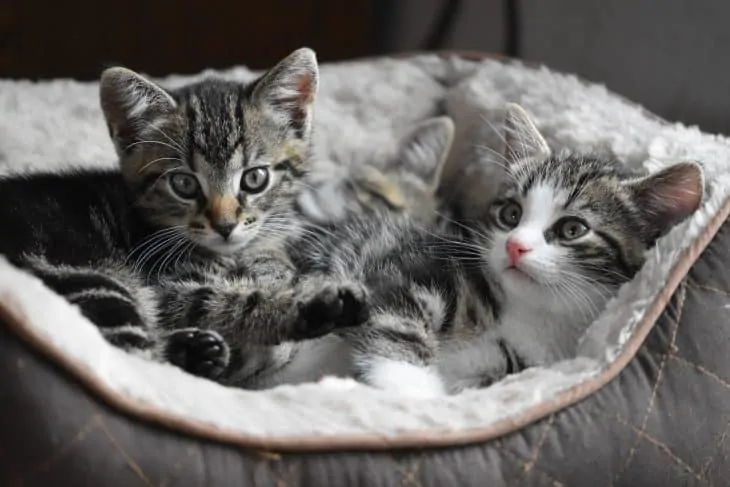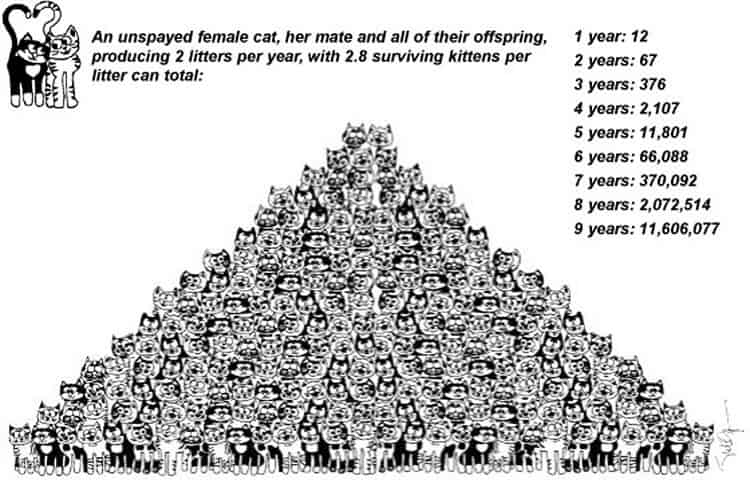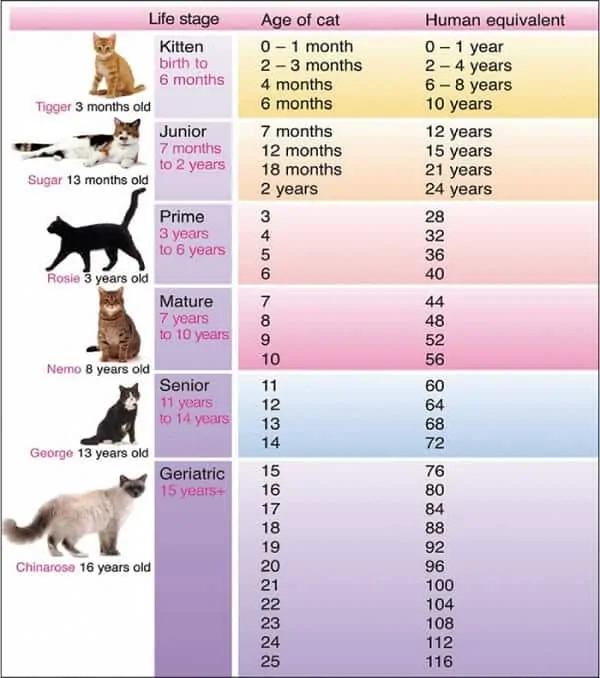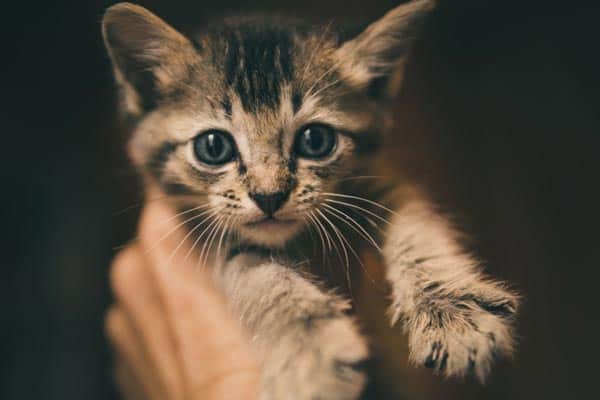
- Kingdom: Animalia
- Class: Mammalia
- Family: Felidae
- In a Litter: Up to 5 kittens
- Newborns: Blind, deaf, dependent on their mother
- Age They Can Leave Their Mother: 8-12 weeks
- Diet: Mother’s milk in the early stages, afterwards weaned onto solid foods
- Behavior: Playful, curious, running, jumping, socializing, purring
- Vaccinations: FVRCP
- Neutering: Can be done from the age of 7 weeks onwards, usually happens at 7 months
- Definition: The Young of Domesticated Cats Are “Kittens”, Not “Cubs”
- Birth: There Are 2-5 Kittens in a Litter
- Birth: Newborn Kittens Are Completely Helpless
- Behavior: Newborn Kittens Are Blind
- Health: A Mother’s Milk Protects Kittens against Disease
- Behavior: Kittens Socialize in Order to Learn
- Development: It Takes Roughly a Year for a Kitten to Become a Cat
- Health: You Should Never Buy a Kitten That Is Younger than 8 Weeks Old
- Health: Kittens Should Be Vaccinated at 2-3 Months Old
- Behavior: Neutering A Kitten Makes It More Friendly
- Kittens Can Be Hand-reared but They’re High Maintenance!
- Orphaned Kittens Are More Moody
- “Kitten” Comes from Old French, and Literally Means “Little Cat”
- A Kitten’s Purring Keeps It Healthy
- Owning a Kitten Can Be Good for Your Health
- All Kittens Are Born with Similar Eyes, but Very Different Noses
- Kittens Have a Special Place in Internet Pop Culture
- Never Give Your Kitten a Saucer of Milk
- Elsa the Kitten Recently Survived Sub-Zero Temperatures
- A Kitten Is for Life, Not Just for Christmas
Kitten Facts Infographics

The Young of Domesticated Cats Are “Kittens”, Not “Cubs”
When it comes to the naming of infants in the animal kingdom, things can get confusing! There are various terms to describe newborn mammals depending on the species, including cub, kitten, pup, kit, whelp, baby, fawn and foal. Sometimes the distinctions are not at all clear − a baby fox, for example, can be known as a cub, kit, kitten or pup. And one word doesn’t necessarily cater to just one biological family. The word kitten can describe young cats, rabbits, squirrels, beavers, foxes or badgers. However, when it comes to the feline family, we can use size to find a rule. The infant of a domesticated cat is known as a kitten, while for big cats, such as lions or tigers, the young are described as cubs.
There Are 2-5 Kittens in a Litter

Our round-up of kitten facts begins with the birth of a litter. Once impregnated, a cat’s gestation period is 64-7 days. When she’s ready to give birth, a mother cat will settle into a birthing bed or den of her choice, and give birth to a litter over a time period that can range from 2-24 hours. There are usually 2-5 kittens in a litter, and they are born at 30-45 minute intervals. Some are born head first, much like human babies, but others come out feet first. Kittens emerge from their mother in an amniotic sac which their mother immediately bites off and eats.
Newborn Kittens Are Completely Helpless
There are many interesting kitten facts relating to how dependent these infants are upon their mothers in the early weeks of their lives. Kittens are born with tightly sealed eyes and ears, and for several weeks they spend their time sleeping and nursing. At this point, young kittens can’t even defecate or urinate without being stimulated by their mother! Kittens are also unable to regulate their own body temperature for three weeks, so it’s really important that they be kept in temperatures of 27 °C (81 °F) or above. Their mother helps to keep them warm with her body at this time.
Newborn Kittens Are Blind
At around 7-10 days after birth, kittens open their eyes for the very first time. At this point, their vision is still blurry, since the retina in the eye is not yet fully developed. One of the more surprising kitten facts is that although after a few weeks the kittens will be able to focus well, they don’t develop eyesight equivalent to an adult cat until around 10 weeks after birth. During this period, their hearing is also developing, and their legs are becoming strong enough to begin holding weight. When a kitten does take its first steps, it learns quickly, and after just a few days will be scampering and climbing all over the house!
A Mother’s Milk Protects Kittens against Disease
Some of the most important kitten facts for those looking after newborns relate to the importance of mother’s milk. The milk provides important nutrients, including protein, fat and various vitamins, which help the young kitten to develop and grow. But, more than that, a cat’s milk contains important antibodies which help little kittens to develop and boost their immune systems, while also protecting them against infection. Newborns also need plenty of fluids, which they get from the milk, since for the first few weeks they are unable to produce concentrated urine.
Kittens Socialize in Order to Learn

One of the kitten facts that make them so adorable to humans is how sociable and playful they are. Once kittens are old enough to walk, run and interact, they seem to do little else with their waking hours. This is because kittens learn through play, so all of the climbing, scampering, biting, stalking, meowing and so on emulates actions they will need to know as older cats. There are some interesting kitten facts about the way this playful socializing develops over time. It has been found that kittens go through learning stages. For example, 3-4 months after birth, is the peak time for interaction with other kittens, so at this stage kittens play intensively together. At around 5 months of age, on the other hand, solitary behaviors become more important, and kittens will spend time developing and practicing their skills in stalking and hunting.
It Takes Roughly a Year for a Kitten to Become a Cat
When we discuss kitten facts, we are usually describing juvenile cats under the age of 1 year old. Yet, while a cat reaches adulthood after 12 months, there are many incredible kitten facts relating to just how quickly these animals develop early on. Between the ages of 2 and 7 weeks old, for example, their eyesight and hearing will dramatically improve, and they will develop their strength, coordination, balance, communicative abilities and more. They also learn techniques which will enable them to care for themselves later in life, such as washing themselves. In domestic situations, kittens are generally fed by their owners. However, in the wild, the mother cat would teach her kittens to hunt by initially bringing live prey into the den for the kittens to learn to kill, and gradually taking them out to observe and emulate her hunting techniques.
You Should Never Buy a Kitten That Is Younger than 8 Weeks Old

We have seen from our review of kitten facts so far that these little creatures rely heavily on their mothers, in everything from the important nutrition in their milk to the training they receive in necessary life skills. For this reason, responsible cat breeders are careful about when they separate a kitten from its mother. It is sadly quite common for kittens to be sold or given away between 6-8 weeks of age, but scientists suggest that staying with their mother and siblings for up to 12 weeks is much more beneficial for a kitten’s social and cognitive development. Indeed, because of this it is highly discouraged – and, in some parts of the world even illegal – to sell kittens younger than 8 weeks old.
Kittens Should Be Vaccinated at 2-3 Months Old
For anyone thinking of buying one, there are important kitten facts regarding health that should be taken into account. One of the first healthcare procedures which a kitten should undergo is vaccinations, at around 2-3 months old. A combined FVRCP vaccination is normally given in Europe and the USA. This vaccination protects against 3 main diseases − Feline viral rhinotracheitis (FVR), Feline calicivirus (C) and Feline panleukopenia (P). This inoculation is given in stages, usually at the 8, 12 and 16 week age milestones. At 16 weeks old, a kitten should also be given a jab which protects against rabies. Young kittens should also be wormed to protect them against roundworm at around 4 weeks of age.
Neutering A Kitten Makes It More Friendly
When it comes to domestic cats, many owners choose to have their cat neutered or spayed (usually “neutered” is used to describe the process with male cats, and “spayed” for female cats). A collection of kitten facts suggest that around 80% of pet cats in the USA are neutered. The process involves the surgical sterilization of a kitten, and usually happens when they are around 7 months old, though it can be done earlier. Not only does neutering prevent the birth of unwanted litters, it can also have a beneficial effect on a kitten’s behavior. Male kittens, once neutered, are often less aggressive, and less likely to participate in sex-related behaviors such as spraying urine, and yowling at females. Both male and female kittens, after the process, are likely to grow up into more friendly, affectionate and gentle cats.
Kittens Can Be Hand-reared but They’re High Maintenance!
As our collected kitten facts have demonstrated, newborn kittens are very vulnerable and require constant care from their mother. This makes caring for them as a human a demanding job, but certainly not an impossible one. In the case of orphaned kittens, for example, hand rearing is an option. Young kittens require milk every 2-4 hours, and need physical stimulation in order to urinate and defecate (this probably won’t be your favorite job!). It’s also important to give such kittens special cat replacement milk.
Orphaned Kittens Are More Moody
There are a few downsides to hand-rearing, though of course if a kitten is orphaned then you might not have a choice. One of the negative effects is that kittens without a mother won’t receive the antibodies they need from her milk, so as adult cats their immune systems may be weaker. There are also some interesting kitten facts which suggest that hand-rearing can affect a kitten’s personality later in its life. Generally, hand-reared kittens are known as being very affectionate with humans. Unfortunately though, it’s not all sunshine and rainbows. Kittens who are brought up in this way are also prone to more temperamental behavior, and mood swings, veering between especially affectionate and more aggressive actions.
“Kitten” Comes from Old French, and Literally Means “Little Cat”
As our kitten facts sheet has proven, the word ‘kitten’ doesn’t necessarily have to describe a baby cat, and could just as easily be applied to cute little foxes, badgers and rabbits. But, from an etymological point of view, the word’s history is rooted in all things feline. The word “kitten” is from the late 14th century, appearing in Middle English as kitoun, ketoun and kyton (spelling wasn’t regulated back then). Linguists believe that the world got into Middle English via the Norman invasion, and actually comes from the Old French chitoun or cheton, meaning little cat. In England, from 1870 onwards “kitten” was a playful term for a young sweetheart, which might be where terms like “sex kitten” come from today!
A Kitten’s Purring Keeps It Healthy
There are some extraordinary kitten facts relating to purring. Kittens learn from a young age to purr when they are happy and relaxed. They purr using their laryngeal and diaphragmatic muscles. They can do it while breathing both in and out, and at a steady pace, creating a pattern of about 25-150 Hertz.
We know that kittens love to purr when they’re happy − but what else can purring do for them? Amazingly, scientists have discovered that sounds produced at this frequency can actually improve bone density and promote healing! For most mammals, the daily strain of moving around keeps their muscles and bones strong. But all cats, and especially kittens, spend a great deal of time asleep to conserve energy. How do they counter this? Scientists have speculated that purring might be how these felines get the best of both worlds. Purring as a mechanism takes very little energy, but still stimulates the muscles and bones.
Owning a Kitten Can Be Good For Your Health

Even more incredibly, these healing benefits are not just limited to your kitten − they could help you, too! Early evidence drawn from studies of cat and kitten facts suggests that in humans, the sound of purring might be enough to lower stress levels, reduce blood pressure, and heal bones and muscles. A recent study even suggested that cat and kitten owners had a 40% reduced risk of heart attack. And there’s one group for whom this could be a particularly important breakthrough; astronauts! All that time in a zero gravity and fairly cramped rocket ship means that the musculo-skeletal systems of astronauts experience less than normal stress levels. These could lead to a wasting effect in tissues and bone, but it appears a soundtrack of kittens purring could be an effective preventative − not to mention cute!
All Kittens Are Born with Similar Eyes, but Very Different Noses
Just like human babies, all kittens are born with blue eyes. This is for the same reason as in humans − because the brown pigment melanin has not yet been deposited in the irises of the eye, or darkened by exposure to ultraviolet light. When it comes to other kitten facts about the body, it is a very different story. While kittens have similar eyes, their little noses are the equivalent of a human fingerprint, and no two noses are ever quite the same. Kittens also have a stronger and more dominant paw, just like we have a stronger hand. Interestingly, though, in kittens the difference is often gendered, and female kittens are usually right-pawed while their male siblings tend to be left-pawed.
Kittens Have a Special Place in Internet Pop Culture
It’s not the most revolutionary of kitten facts − they are very, very cute! In recent years, however, internet users have found many new and creative ways to express that aaaaaww feeling that we all get when we look at a kitten. From Pinterest boards depicting famous people holding kittens, to YouTube channels that can make particularly cute kittens famous overnight, the list seems endless. One of the best roles that the internet has elevated the kitten to is the cheering people up function. Having a bad day? Many popular sites hold the philosophy that there is no problem that looking at a picture of a cute kitten can’t solve. These include the World Famous Random Kitten Generator and the Twitter account @emergencykittens, which brings you regular kitten pictures for all your daily kitten needs.
Never Give Your Kitten a Saucer of Milk
When it comes to myth-busting kitten facts, this might be the biggest one. Everywhere, from books to films, and especially in cartoons such as Walt Disney’s The Aristocrats and Warner Bros’ Tom and Jerry, most of us have grown up seeing images of cats and kittens happily drinking from a saucer of milk. In fact, many kittens are lactose intolerant, and will get upset stomachs if they have too much milk. Even if it doesn’t cause an allergic reaction, for a kitten to drink a saucer of milk is the calorie equivalent of a child eating over four burgers!
Elsa the Kitten Recently Survived Sub-Zero Temperatures
As we already know from our previous kitten facts, young cats are very sensitive to temperature, and harsh environmental conditions can be fatal to them. Imagine rescuers’ surprise then, when they found a small ginger kitten tangled in electric wires on a porch in freezing Denver this year, and managed to save her! At the time, she was so near to death that her temperature didn’t even register on a thermometer. By using heating pads, hair dryers and blankets, the rescuers managed to warm her up, and now the kitten, named Elsa, has made a miraculous recovery!
A Kitten Is for Life, Not Just for Christmas
Whether we are discussing puppy or kitten facts, the main thing that children should understand is that a pet is a big commitment, and will need looking after long after the initial novelty has worn off. But this doesn’t have to be a bore − kids can have fun as they learn to care for pets, and take pride in these new skills. Help your child to gain a sense of responsibility for their new kitten by teaching them to feed and clean it, as well as just playing with it.
Kitten Facts – Facts about Kittens Summary
 A kitten is a juvenile domestic cat, usually in the first year of its life, although the term ‘kitten’ can also be used to describe the young of several other mammals. Newborn kittens are blind and deaf, and can’t even urinate without stimulation. They are totally dependent upon their mother for several weeks, but after this time they begin to grow and learn, often through socialization and play. Since they are so small, fluffy and playful, kittens are a byword in popular culture for cuteness, to the extent that we joke about kittens being able to “brighten up our days” just by looking at them.
A kitten is a juvenile domestic cat, usually in the first year of its life, although the term ‘kitten’ can also be used to describe the young of several other mammals. Newborn kittens are blind and deaf, and can’t even urinate without stimulation. They are totally dependent upon their mother for several weeks, but after this time they begin to grow and learn, often through socialization and play. Since they are so small, fluffy and playful, kittens are a byword in popular culture for cuteness, to the extent that we joke about kittens being able to “brighten up our days” just by looking at them.
Was this page helpful?
Our commitment to delivering trustworthy and engaging content is at the heart of what we do. Each fact on our site is contributed by real users like you, bringing a wealth of diverse insights and information. To ensure the highest standards of accuracy and reliability, our dedicated editors meticulously review each submission. This process guarantees that the facts we share are not only fascinating but also credible. Trust in our commitment to quality and authenticity as you explore and learn with us.
